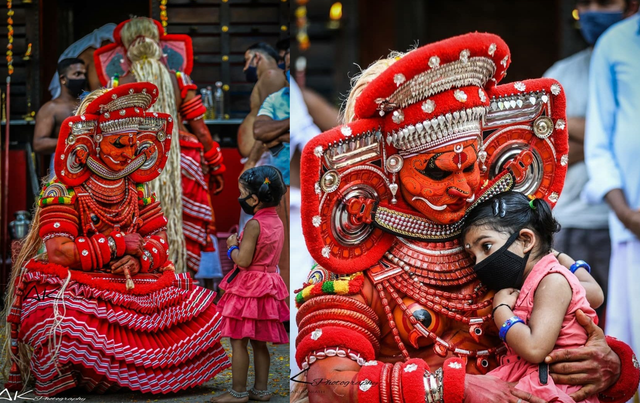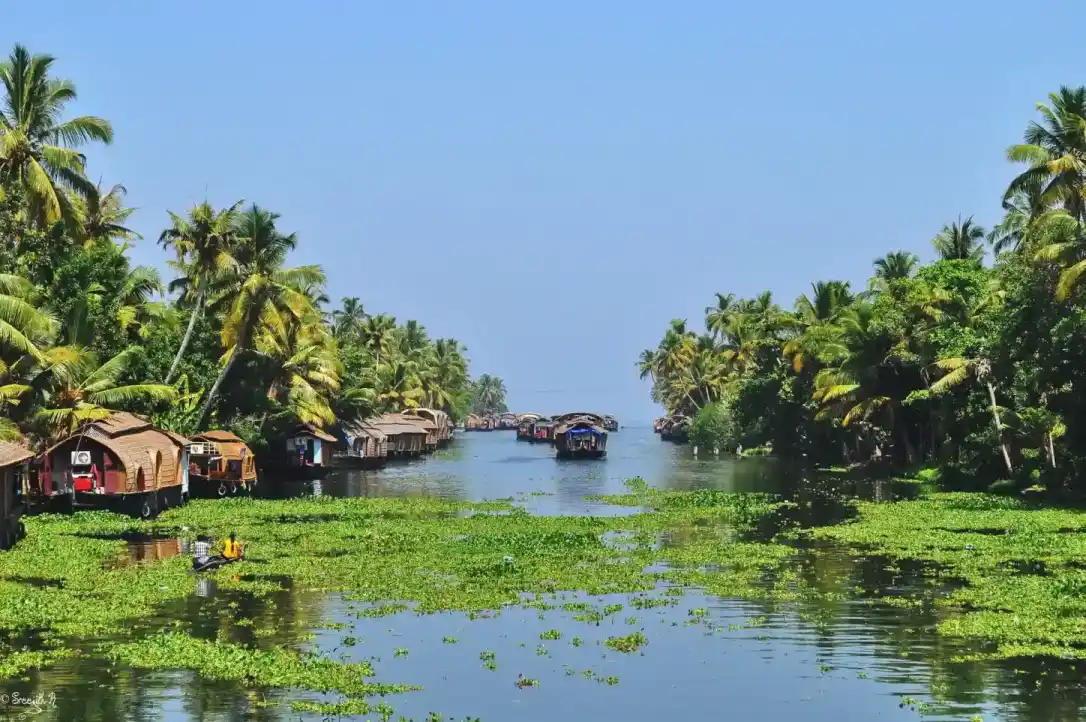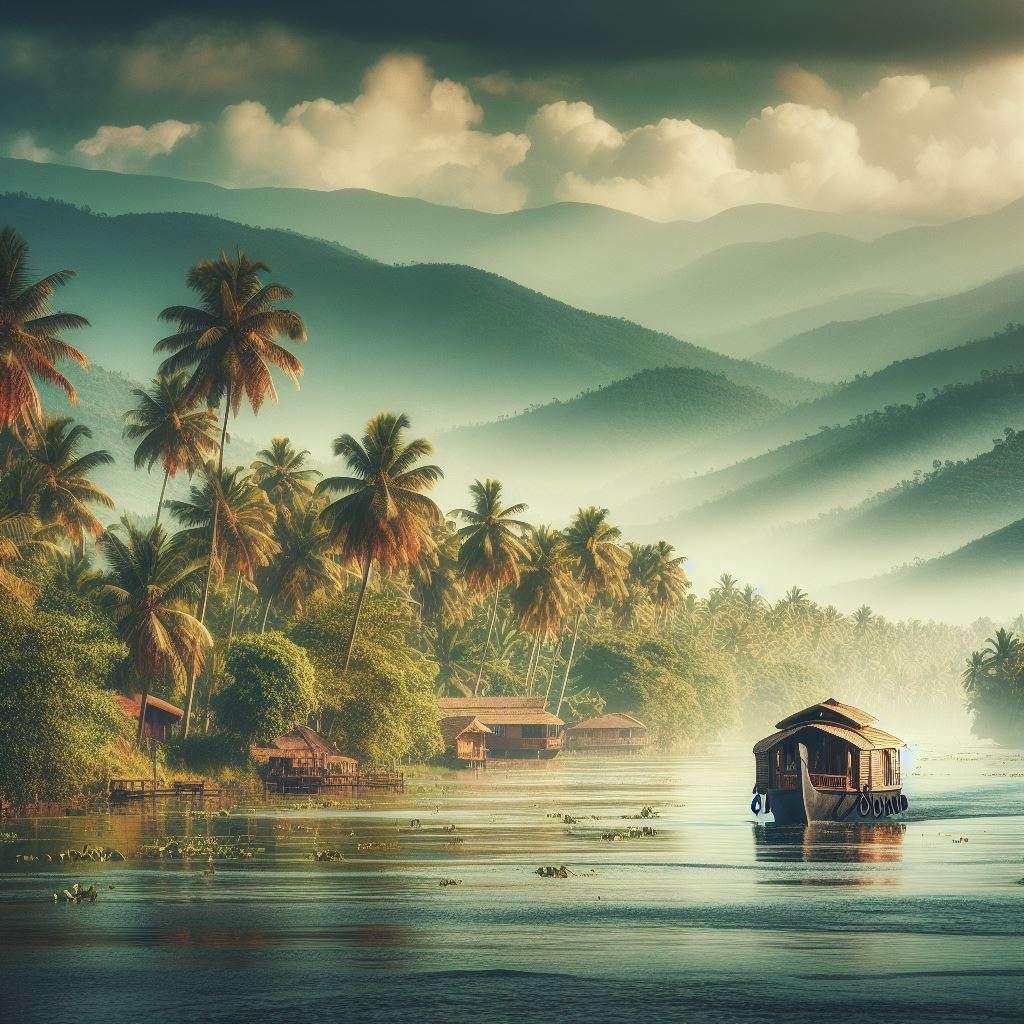
Theyyam is a famous ritual art form that originated in North Kerala which brings to life the great stories of our State. It encompasses dance, mime and music. It exalts the beliefs of the ancient tribals who gave a lot of importance to the worship of heroes and the spirits of their ancestors.
Features of Theyyam

Main feature of theyyam is the makeup and costumes. The power of goddesses, gods, spirits, heroes, demons and many mythological characters is exhibited in the dance. Each Theyyam has different style of body painting. The headwear called ‘Mudi’ too varies.
Theyyam symbolize

The term Theyyam is believed to be a corrupt form of ‘deivam’ meaning God. God is believed to enter the body of the Theyyam performer and, hence, believers consider him as a visible manifestation of God and seek blessings

Story of Theyyam

Theyyam is representative of a form of Hinduism practiced by the tribal communities since time immemorial. The Satvic rituals practiced by the Namboodiri Brahmins in temples co-existed with this tribal form of worship which involves liquor and meat as offerings to god.
Land of Theyyam

-
Kannur
Kannur is dubbed as the City of Looms and Lores, thanks to the flourishing handloom industry and folk art called Theyyam. Theyyamis a ritualistic artform encompassing dance, music and mime, where the artist dons the guise of God. Kannur is believed to have got its name from being the land of Kannan or Krishna.The towns of Kannur and Bekal are good hubs to see Theyyam in Kerala.

There are 456 theyyakkolams.Among this 112 are very important and famous.

-
Vishnumoorthi
-
Sree Muthappan Theyyam
-
Guligan
-
Padikutti Amma
-
Muthappan Anthithira
-
Puthiya Bhagavathy
-
Perum Kaliyattam
-
Agni Kandakarnan
-
Padamadakki Bhagavathy
-
Manakkott Amma
-
Kuttichathan

-
Kathivanur Veeran
-
Puliyur Kali
-
Pullikarim Kali
-
Pulikandan
-
Marapuli
-
Kandapuli
-
Pulimaruthan
-
Padarkulangara Bhagavathy
-
Karinthiri Nair
-
Kuttikol Thamburatti Theyyam
-
Elayor Theyyam
-
Muthur Theyyam
-
Vannathan
-
Chuzhali Bhagavathy
-
Kannangat Bhagavathy
-
Kodoth Chamundi
-
Moovalamkuzhi Chamundi
-
Palot Daivam
-
Dandinganath Bhagavathy
-
Padarkulangara Bhagavathy
-
Karim Chamundi
-
Muthala Theyyam
-
Elleduth Bhagavathy
-
Adukunnath Bhagavathy
-
Narambil Bhagavathy
-
Chembilot Bhagavathy

-
Pulichon
-
Vellarangara Bhagavathy
-
Mayyakkal Bhagavathy
-
Koroth Naga Bhagavathy
-
Padinhare Chamundi
-
Vettakorumakan
-
Mavila Chamundi
-
Urpazhassi
-
Kudiveeran
-
Veerabadran
-
Vishakandan
-
Kandanar Kelan
-
Vayanat Kulavan
-
Kunhiraman Gurukkal
-
Munnayareeshwaran

-
Manavalan
-
Manavatti
-
Manjalamma
-
Thoovakkari Muthappan
-
Karimanal Chamundi
-
Peruvamba Chamundi
-
Eroth Chamundi
-
Kizhakkeveettil Chamundi
-
Kaitha Chamundi
-
Madayil Chamundi
-
Pethalan
-
Pullon
-
Chooliyar Bhagavathy
-
Kodoth Chamundi
-
Olassa Poomala Bagavathi
-
Astamachal Bagavathy
-
Nagacherry Bhagavathy
-
Meethale Theyyam
-
Oyola Bagavathi
-
Padaveeran
-
Pallivettakkorumakan
FACE AND BODY DRAWING

Each theyyam has a distinctive type of body and face painting. In body painting parunthuval ezhuthu ( eagles tail ) and anchupulli ezhuthu ( five circles) are some technical terms used. They are named after animals and birds or flowers signifying some of their traits. Thus each face drawing style is called a distinctive name.
Face drawing and body painting are the main aspects of decoration and make up. The different types of face drawings are: vairedala mankannu- doe eye signify feminine quality and beauty, podipum thelval kannum- eye shaped like a scorpion tail, certain theyyams have a specific style of facial drawing:prakezhuthu- in case of thai paradevath, kuttishankum and prakum, In case of muchilot bhagavathy, hanuman kanittezhuthu.- in case of bali Theyyam, vatakkanu ezhuth- in case of vishnumurthi, narikuzhicha ezhuthu and irattuehurulit ezhut are some types of other facial drawings.

In the makeup usually natural herbal colors are used . the usual products used for makeup include kasthuri- musk, kunkumam-saffron powder, chayilyam- vermilion, chunnam- quick lime, aripodi- rice powder, manjal- turmeric. All the colors prepared are made into a paste either with water or coconut oil as a base. For instance , preparation of mascara is done by heating an earthen vessel with a lamp using coconut oil. Raw turmeric is boiled and its oil is extracted and used for certain processes. The brush used for painting the face is a coconut leaf stem. How natural it is !
Mostly primary and secondary colors are applied with contrast for face painting. It helps in effecting certain stylization in the dances. Then the dancer comes in front of the shrine and gradually “metamorphoses” into the particular deity of the shrine. He, after observation of certain rituals places the head-dress on his head and starts dancing
FACE DRAWING PATTERNS
-
Pakshithayum suryakannum- pigeon shaped large eyebrow

-
Podipum thelval kannum- scorpion tail.

-
Mannkannum, dalavum- doe eyed and petal styled

-
Churika munayum, anjupulli – five small circles with a rapier – shaped nose

-
Churulum kuriyum – curves and circles style

-
Kodumbhiriyum prakokkum – bird in flight with sun like eyes.

-
Hanuman kannittezhuthu

COSTUMES FOR THEYYAM
-
COSTUMES FOR VISHNU MOORTHY

1. Odachikutti : made of wood with golden serpent like formation
2. Lakshmi kathu : big ear made of bronze
3. Thalathanda : the stem of exora flowers
4. Thalapoli : the ornament tied above the forehead made of silver or bronze
5. Chenipoov : bunch of exora flowers
6. Kuttikathu : small ear made out of wood
7. Odavalayam : a costume worn on the chest as an attachment to the tender coconut fronds
8. Oliyota : costume with combed tender coconut fronds hanging from
COSTUMES FOR MUCHILOT BHAGAVATHY

-
1. Poothanda– garland made of exora flowers which forms the outer most border of the headdress
-
2. Pathi– cloth border with embroidery
-
3. Mallika – flowers made of tender coconut fonds on a shining brass or silver circular plate
-
4. Chekki – exxora flowers with thin stems attached
-
5. Silver papers
-
6. Flowers made of tender coconut fonds tied to a blue shining paper
-
7. Chekkimala – hanging garlands of exora flowers is a semi circular pattern
-
8. Thalathanda – t he stem of exora flowers
-
9. thalapoli – The ornament tied above the forehead made of silver or bronze
-
10. poyikannu – silver goggles
-
11 . ekali – teeth fangs of silver
-
12. olakkattu – big ear made of bronze
-
13. kazhatikettu – an ornament carved in wood representing garlands
-
14.arimbumala– garlad that connects the two olakadu.
-
15. eiyaram– an ornament carved in wood covering the chest in full
-
16. pantham– a big flaming torch on long sticks
-
17. munkaivala– bangle worn on the forearm
-
18. choodakam – a bronze ornament tied close to the poothanda
-
19. poothanda– garland made of exxora flowers tied on the wrist
-
20. chendu valayam – an attachment to the cotume tied round the waist
-
21. vithanathara – a dress made of red cloth with artistic designs having white and black borders
-
22. chilambu – a big jingling ankle ornament.
COSTUMES FOR SHASTHAPPAN

-
1- pattam : wooden plank with woolen thread, peacock stems and mirror work
-
2- poykannu: a small holed eye cover prepared out of wood
-
3- mukhashobha : ear designs made of peacock feather stem and woolen threads
-
4- marameesha: the moustache made out of wood
-
5- marathadi: the beard made out of wood
OTHER COSTUMES COMMONLY USED FOR THEYYAM
Other jewellery worn by are ornaments such as bracelets, bangles and anklets, flower garlands and female characters are provided a breast plate fashioned out of coconut shell. The skirts are made of bamboo splices and coconut sheaths painted red and black or from red cloth tied around bamboo sticks. A red waistband is usually worn. Painted wooden masks also used for some theyyams.
-
EAR( MUTHAPPAN )

-
THALATHANDA – the stem of exora flowers

-
FACE MASK ( POTTAN THEYYAM )

-
VITHANATHARA – a dress made of red cloth with artistic designs having white and black border

-
CHILAMBU– a big jingling ankle ornament.

-
OLAKKATU– big ear made of bronze

-
MUNKAIVALA- bangle worn on the forearm

-
HEAD GEAR ( PULIYOOR KALI )

-
HEAD GEAR (MUCHILOT BHAGAVATHI

-
HEAD GEAR ( DAIVATHAR)

-
KAZHATIKETTU – an ornament carved in wood representing garlands

-
HEAD GEAR ( VETTAKORUMAKAN)

-
HEAD GEAR ( PUTHIYA BHAGAVATHY ) WEARINGS MADE OUT OF COCONUT FRONDS

-
HEAD GEAR VISHNUMOORTHI

-
WEARINGS ( MALE GODS

-
WEARINGS ( KOPPALAR, PULAYA, COMMUNITY THEYYAMS)

-
HEAD GEAR MUTHAPPAN

-
HEAD GEAR THIRUVAPPANA

-
WEARINGS ( FEMALE GODS

Another Theya season has begun in Thulapat, Uttara Kerala.

Temples, kavas and kazakas prepare for the arrival of the Teyyakalam on the 10th day of the festival, and the festival begins with a play held at the Anjuttambalam Virar Kavi in Nileswaram
Beyond rituals, Theyam is also an art form that combines the culture and heritage of a country.
Apart from the kolas, the temple ritualists, valyakars and marketers all have busy days.




